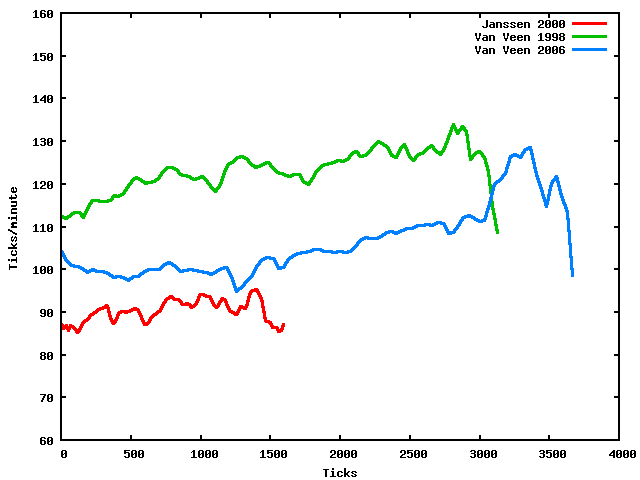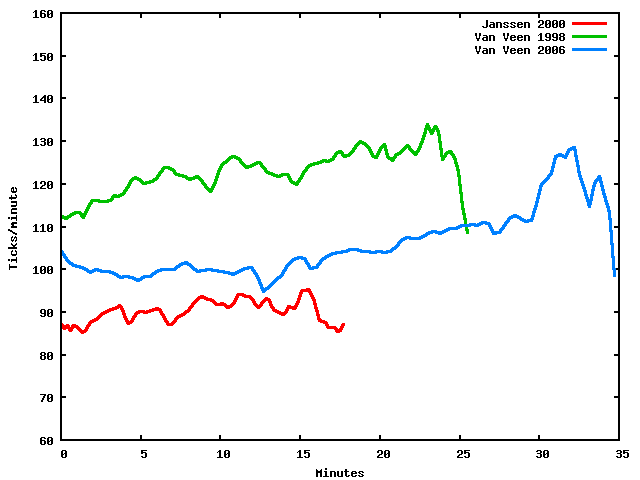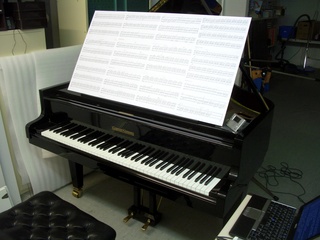
This is a timing comparison of three different recordings of the solo piano piece Soloduiveldans IV written by dutch composer Simeon ten Holt. The three recordings are:
Being an amateur, i like the piece Soloduiveldans IV by Simeon ten Holt very much. First i was attracted by Jeroen van Veen's breakneck recording from 1998. When i the found his Brilliant Classics recording from 2006, i wondered why this sounds even more ecstatic than his 1st one, and it seemed to depend partially on the architecture of speed, a parameter that is well accessible. So i tried an experiment to visualize the speed in these recordings, using an objective measurement.
The timing of the pieces was taken using a tiny C program timer.c on a PC running debian Linux. While listening and enjoying the pieces, i followed the beat of the music by rhythmically pressing the return key on the keyboard. This produced a text file timer.log with a list of timestamps (ticks). By building the inverse of the time difference between successive ticks (a task for an awk script), the ticks/minute were calculated. The program gnuplot was used for plotting, with bezier smoothing of the curves. As i don't have the score, i don't know the relationship between ticks and bars (which is a constant number).
Now one can plot the ticks/minute over the ticks making up the piece. This shows the speed of playing while walking through the score. However the actual score during performance is not fixed as one can see. The total number of ticks and therefore the length of the piece rather depends on the repetitions the pianist puts into his interpretation.

From the plot above one can see that van Veen's 2006 recording is the most elaborate one in the sense that it contains the most bars (by arrangement and repetitions). In comparison Janssen's recording from 2000 is a rather short interpretation, with reduced number of repetitions. But it's not so much shorter in absolute time due to slower playing, as one can see below. There are also common speed patterns discernible, particularly when looking to the two van Veen recordings.
One can also plot the ticks/minute over the real time axis. This allows e. g., to locate points in the piece by use of the time display of the audio player:

Interestingly, the time taking was more difficult (requiring more concentration) with Janssen's recording from 2000 than with the other two ones, as in his recording there is often more weight on off-beat notes, which appears as phase shifts and energy exchanges between melodies that add to the polyphonic complexity of this interpretation. All this with a rather constant walking tempo, and modesty. Very enjoyable.
Part of the magic of van Veen's 2006 recording is in its judicious overall tempo design coupled with elaborate dynamics, allowing to extend it to 35 minutes. There is a drive by a sustained gradual (and increasing) acceleration from about minute 13 throughout towards the climax near the end, particularly by using very funny accelerator loops, kinda LHC in music :-) Perfect. Anyway, hear yourself...
Thanks go to Hans Hagen, who made me aware of Simeon ten Holt's music.
This page first put online 3 October 2008.
Yes, i have the score, since about 22 October 2008. The look of the piece was a big surprise for me, never guessed that one magic would be that left and right hand fingers are interwoven in this way.
Found the funny off-beat notes from Janssen's recording, they are, e. g., the octaves in bar 37 and following.
While exercising Chopin op. 10 no. 1 with stiff fingers, bars 37 to 39 of the Soloduiveldans IV were a welcome distraction (got nearly addicted). After looping through them and neighbors for an hour or so, when coming back to the etude, it rolled more smoothly. Soloduiveldans is good for your fingers :-)
Been wondering what in Soloduiveldans IV reminds me at Bach, kind of dejavou. At least the chromatic progression in bar 40 and following rang a bell today: begin of the last part (Lentement) from the Fantasia in G Major, BWV 572.
Another dejavou in bar 18: Jardins sous la pluie (Estampes) by Claude Debussy.
 Finally no need anymore to turn pages during exercising,
and it teaches to sit upright :-)
Finally no need anymore to turn pages during exercising,
and it teaches to sit upright :-)
I have glued slightly reduced fotocopies of the score on a 115 cm x 61 cm cardboard (12 of 13 sheet, leaving out the 1st one).
Meditatio-ruminatio (Anselm Grün, Einreden, 1983).
Another remembrance: Le Tic-Toc-Choc au les Maillotins (Francois Couperin).
Heard Eadem Sed Aliter for the 1st time (Jeroen van Veen recording, 2012). Heavenly.